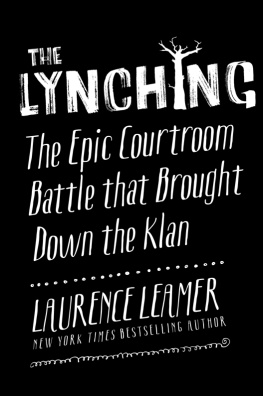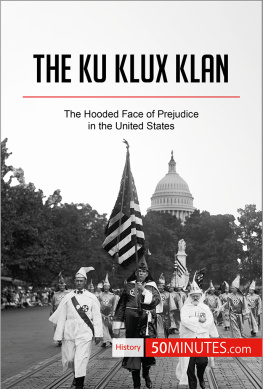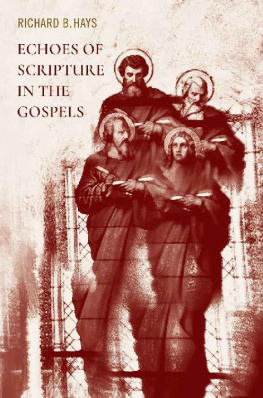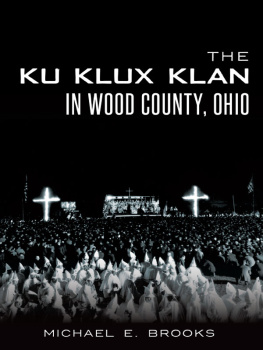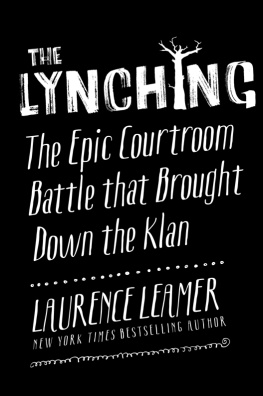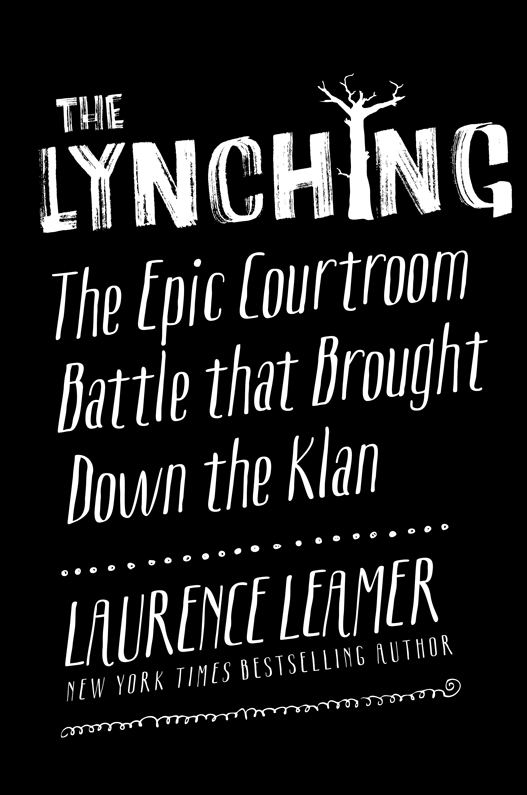EARLY SATURDAY MORNING on March 21, 1981, a young woman was out riding her bicycle with her dog along Herndon Avenue in Mobile, Alabama, a modest residential street no more than three hundred yards long. It was the first day of spring, and in the predawn light, the woman saw what she assumed was a dummy hanging from a camphor tree and continued down the road. A few minutes later, an elderly man went out to buy the morning paper and saw what he figured was a black man breaking into a house. Once he got back to his own home, he called the police. Other passersby saw what they thought was a man strung up by a noose, his feet barely off the ground, and they too phoned the police.
When the officers arrived there shortly after dawn, they found the body of a black man hanging from a tree. They cordoned off the vacant lot at 112 Herndon Avenue but left the body there and waited for the coroner to do the job of taking it down and removing it. When one black person heard about the murder, he called a friend, and that person called someone else, and soon scores of black spectators arrived.
There had not been a lynching in America in a quarter century, and no one standing looking at the body had ever seen such a crime, but they had heard about it from family members and read about it in social science books in school. And they believed they knew what had occurred. White men had lynched a black man, and they had done it to send a message of intimidation and terror. This was something they thought would never happen again, and many of the black onlookers wept, others fell to the ground beating their fists against the earth.
AT THE WEEKLY meeting of Klavern 900 of the United Klans of America (UKA) in Theodore, Alabama, on March 18, 1981, Bennie Jack Hays stood before the dozen Klansmen and raged against the rise of black people. Bennie was the Great Titan, the highest-ranking officer of the UKA in the southern half of Alabama. The bespectacled, white-haired sixty-four-year-old might have spent his last years rocking his grandchildren on the porch, but he had risen quickly in the Klan despite being Catholic in an overwhelmingly Protestant organization that had once considered Catholics no better than infidels.
The Klan leader lived in a house on seven acres in Theodore, which was fifteen miles southwest of Mobile. Theodore was a poor white mans redoubt, small homes and trailers spread out among the jungle-like foliage. It was as close to paradise as Bennie was likely to get, especially because he had a cabin for Klan meetings on his property.
The Klansmen attending the evening assembly sat in several rows of chairs. An altar-like shrine stood in the front of the room. There set a candle, a container of water, an open Bible, and an American flag with a cross laid across it. A Confederate flag stood in the corner.
Your Excellency, the Sacred Altar of the Klan is prepared, the Fiery Cross illumines the Klavern, said Thaddeus Red Betancourt, the Klokard or teacher, pointing to the lit candle.
Klansmen, what means the Fiery Cross? asked Bennies son-in-law Frank Cox, the Exalted Cyclops or Klavern president.
We serve and sacrifice for the right, said all the Klansmen.
No one in the Klavern spoke the sacred language with more passion than did Teddy Lamar Kyzar. He was a plump, expressionless young man with an enormous head and pink, baby-like skin. Kyzar stood just barely over five feet and looked like a boy among grown men. A few years before, a group of black men had stolen Kyzars watch. From then on, he had hated the whole race, and the Klan gave him the chance to strike back.
Some of his fellow Klansmen dismissed Kyzar because of his height, but that just compelled him to do almost anything to be accepted as their equal. He placed himself at the head of the line volunteering for what the UKA called missionary work, and his favorite involved beating up black men.
When the Klansmen had their victim bloodied, bruised, and spread-eagled on the ground, the last thing they did before walking away was to tell the man straight-out: The cops are Klan, and you go to the cops, and well come back and kill you.
Kyzar lived in Mobile on Herndon Avenue in one of the four houses Bennie owned and had broken up into apartments. A few weeks earlier, the Klan leader had come to the street and thundered about whites watching black Mardi Gras parades.
For the next black parade, Bennie commanded that Kyzar and some other Klavern members slash tires all around the area and ordered that the tires be cut on the sides so they could not be patched and that at least two tires of each car be punctured. The Klansmen waited until the sounds of music and cheers wafted out across the streets and then started slashing and puncturing away. Kyzar bragged that he had damaged tires on sixty-five cars in one parking lot alone.
That had been a great day for Kyzar, but since then, he had gotten in trouble. He had taken a recruits application money and spent it at a bar. The Klavern could have decided he was not proper Klan material and thrown him out. But he was liked by a number of Klan members, and the group decided instead that they would whip him.
Kyzar shuffled to the front of the room. If he had walked out of the meeting, no one would have stopped him, but these were his friends and he was part of what he considered a marvelous kinship, and he knew he had to take his punishment.
Per protocol, the sacred items were taken off the altar, and Kyzar knelt down with his hands on the wooden surface. After a few words justifying and ennobling what was about to take place, the Exalted Cyclops hit him with a leather belt. Kyzar tried not to flinch or to show any pain, but he was close to crying. After the Exalted Cyclops struck him the last of the required fifty lashes, Kyzar limped back to his seat.
The men deferred to Bennie not only because he was the Great Titan, but also because they saw him as a man of a substance far beyond theirs. Bennie also had all kinds of properties and business interests to which they could hardly dare aspire.
He was born Herman Otto Houston in rural Missouri in 1916. His own father was a drunk, and for a time, the family was so poor they lived in a tent on the riverbank. At age sixteen, the illiterate teenager left home for good.
Bennie loved to spin tales of how he had ridden the outlaw roads with the infamous Bonnie Parker and Clyde Barrow of criminal legend. It seemed an unlikely story, but Bennie had such vivid details that his family thought it was probably true. He talked too about what it was like jumping into some of the worst hellholes on the European front as a paratrooper in World War II. After the war, he was twice sent to prison, once for cattle rustling and then for check forging. In 1952, he saddled a horse and fled from the prison farm.
The escaped convict was able to build a new life for himself with a new name, Bennie Jack Hays. By the time the police tracked him down, he was married to Opal Grace Frazier and had two young sons, Raymond and Henry. While he served out his remaining time in prison, Opal picked cotton and had a daughter, Gail, by another man.
When Bennie was released, he moved with his wife and three children to Charleston, South Carolina. He worked tearing up old rail tracks from Texas to New York and was gone weeks at a time. That wasnt getting him anywhere, and one day in 1969, he put the familys meager belongings in a car and drove to Mobile for a new start.

